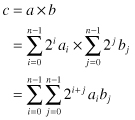2.3 PARALLELIZING ALU STRUCTURE
Parallel structure implies using several copies of the same hardware in the ALU. An example of use of parallelism to enhance performance is the multiplication operation. Before the days of very large-scale integration (VLSI), early computers could not afford to multiply numbers using a dedicated multiplier. They used the adder in the ALU to do multiplication through the add–shift technique. Assume the two numbers to be multiplied, a and b, have the following binary representations:
where ai, bi = {0, 1}. Equation 2.2 could be thought of as the parallel implementation of the multiplication operation. Essentially, we are forming all the partial products aibj and then add them together with the proper binary weights. Equation 2.3 is the bit-serial implementation. Here we add the partial products over two stages first along the j index then add the results over the i index. This will be explained shortly. Some authors refer to this operation as serial/parallel multiplication since 1 bit is used to multiply the other word.
Figure 2.1 shows the bit-serial multiplication technique for the case n = 4. The multiplicand b is stored in a register and the multiplier a is stored in a shift register so that at each clock cycle, 1 bit is read out ...
Get Algorithms and Parallel Computing now with the O’Reilly learning platform.
O’Reilly members experience books, live events, courses curated by job role, and more from O’Reilly and nearly 200 top publishers.



